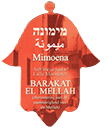This is a concert of Jewish music live from Morocco. The traditional Jewish music in this concert is Andalusian music (also called tarab music), which originated in the region of Andalusia in south-central Spain, took root among the Jews of Morocco, Algeria and of Tunisia, and has been interpreted and expressed at every event, period and time in the circle of Jewish life.
Among those who emerged from these communities were great poets, starting with Rabbi David Hasin and ending with contemporary Rabbi David Bozaglo, famous musicians, conductors and singers who were considered cultural figures in their respective countries.
Andalusian music is a very central element not only in the artistic music of the Muslim residents of Morocco, but also plays a very important role in the music of the Jews of North Africa, especially in the prayer song ceremony. Faced with the vast repertoire of the Andalusian ala, many piyot were written in Hebrew, in many cases in a manner that preserves the basic meter and timbre of the Arabic original. This process, which speaks to the deep connection of North African Jews to Andalusian music and culture, allowed Jews to adopt Andalusian music into the world of piyot and prayer.
The most significant immigration of Jews to Morocco followed the expulsion from Spain in 1492. Although Sephardic Jews from the Iberian Peninsula had settled in North Africa even before their final expulsion from Spain in 1492, the large Immigration and mass settlement took place after the expulsion.
North Africa has served as an important center for poetry and poetry throughout all eras. Thousands of piyuts were created among Moroccan Jews from the 10th century to the present, many of them still found in manuscripts. There are many anonymous poets whose authors are known to us only by their first names. From the remains of piuts from the 10th and 11th centuries, we learn that in North Africa, piuts were written in the style of ancient Israelite piut, such as the poetry of Rabbi Yehuda Ibn Quraish, Rabbi Adonim bar Nissim Halevi and by Rabbi Elazar ben Aharon Passi.
The poetry of Spain had a considerable influence on the Hebrew poetry of North Africa. These two centers of Judaism – Spain and North Africa – were in close contact in many areas – halakha, linguistics, poetry and more. The poets of North Africa were well acquainted with Spanish work and in their poetry one can find a direct influence of Spanish poets. After the expulsion from Spain, Spanish poets settled in Morocco, where they continued to write poetry in the style of the poetry of the Jews of Spain. Thus, Spanish poetry continued to directly influence North African poets.
The musical traditions of Moroccan Jews are distinguished by an impressive diversity and great musical richness. These traditions have developed over hundreds of years among the Jewish communities of Morocco and include liturgical (prayer) music, Piyot music and within it the unique tradition of chanting petitions, Andalusian music and folk music. . These musical traditions arrived in Israel following the immigration of Moroccan Jews in the 1950s and 1960s, and despite the great cultural crisis that occurred within this community in Israel, the community has preserved the tradition that it had.
Today, there is a revival of the musical traditions of Moroccan Jews. The Chanting of Requests is performed in many locations across the country each Shabbat night between Parashat “Bereshit” and Parashat “Zakor”. A new generation of professional bards is born, specializing in Moroccan-style piyot singing, Andalusian music is alive and well in the performance of the Andalusian orchestra, which has become an integral part of the musical landscape of the State of Israel .
The rich musical tradition of the Moroccan Jewish community has received new impetus in recent years and is an important component of Israeli culture and society.



